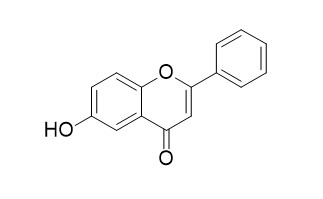6-Hydroxyflavone
6-Hydroxyflavone was previously reported to bind to type A γ-aminobutyric acid (GABAA) receptors benzodiazepine (BZ) site with moderate binding affinity, it as a promising drug candidate for the treatment of anxiety-like disorders. 6-Hydroxyflavone and 6-methoxyflavone with potent anti-inflammatory activity jin kidney mesangial cells provides a new flavone scaffold and direction to develop naturally derived products for potential nephritis prevention and treatment.
Inquire / Order:
manager@chemfaces.com
Technical Inquiries:
service@chemfaces.com
Tel:
+86-27-84237783
Fax:
+86-27-84254680
Address:
1 Building, No. 83, CheCheng Rd., Wuhan Economic and Technological Development Zone, Wuhan, Hubei 430056, PRC
Providing storage is as stated on the product vial and the vial is kept tightly sealed, the product can be stored for up to
24 months(2-8C).
Wherever possible, you should prepare and use solutions on the same day. However, if you need to make up stock solutions in advance, we recommend that you store the solution as aliquots in tightly sealed vials at -20C. Generally, these will be useable for up to two weeks. Before use, and prior to opening the vial we recommend that you allow your product to equilibrate to room temperature for at least 1 hour.
Need more advice on solubility, usage and handling? Please email to: service@chemfaces.com
The packaging of the product may have turned upside down during transportation, resulting in the natural compounds adhering to the neck or cap of the vial. take the vial out of its packaging and gently shake to let the compounds fall to the bottom of the vial. for liquid products, centrifuge at 200-500 RPM to gather the liquid at the bottom of the vial. try to avoid loss or contamination during handling.
Evid Based Complement Alternat Med.2021, 2021:5585692.
Arch Biochem Biophys.2018, 644:93-99
Front Pharmacol.2019, 10:1355
Food Bioscience2024, 57:103518.
Vietnam J. Chemistry2022, 60(2):211-222
Sains Malaysiana2024, 53(2):397-408.
Journal of Functional Foods2022, 99: 105331.
Int J Mol Sci.2020, 21(22):8816.
Mol Plant Pathol.2023, 24(2):123-141.
Applied Biological Chemistry2021, 64(4)
Related and Featured Products
Plos one, 19 Mar 2015, 10(3):e0116409.
6-Hydroxyflavone and derivatives exhibit potent anti-inflammatory activity among mono-, di- and polyhydroxylated flavones in kidney mesangial cells.[Reference:
WebLink]
Inflammatory responses by kidney mesangial cells play a critical role in the glomerulonephritis.
METHODS AND RESULTS:
The anti-inflammatory potential of nineteen mono-, di- and polyhydroxylated flavones including fisetin, quercetin, morin, tricetin, gossypetin, apigenin and myricetin were investigated on rat mesangial cells with lipopolysaccharide (LPS) as the inflammatory stimuli. 6-Hydroxyflavone and 4',6-dihydroxyflavone exhibited high activity with IC50 in the range of 2.0 μM, a much better inhibition potential in comparison to the well-studied polyhydroxylated flavones. Interestingly, the anti-inflammatory activity was not due to direct quenching of NO radicals. Investigation on derivatives with methylation, acetylation or sulfation of 6-hydroxyl group revealed that 6-methoxyflavone was the most potent with an IC50 of 192 nM. Mechanistic study indicated that the anti-inflammatory activity of 6-methoxyflavone arose via the inhibition of LPS-induced downstream inducible NO synthase in mesangial cells.
CONCLUSIONS:
The identification of 6-Hydroxyflavone and 6-methoxyflavone with potent anti-inflammatory activity in kidney mesangial cells provides a new flavone scaffold and direction to develop naturally derived products for potential nephritis prevention and treatment.
Biochemical Pharmacology, 2010, 79(9):1337-1344.
GABAA receptor subtype selectivity underlying anxiolytic effect of 6-hydroxyflavone.[Reference:
WebLink]
6-Hydroxyflavone (6HF), a naturally occurring flavonoid, was previously reported to bind to type A γ-aminobutyric acid (GABAA) receptors benzodiazepine (BZ) site with moderate binding affinity.
METHODS AND RESULTS:
In the present study, we showed that 6HF partially potentiated GABA-induced currents in native GABAA receptors expressed in cortical neurons via BZ site, as the enhancement was blocked by the antagonist flumazenil. Furthermore, in patch clamp studies, 6HF displayed significant preference for α2- and α3-containing subtypes, which were thought to mediate anxiolytic effect, compared to α1- and α5-containing subtypes expressed in HEK 293T cells. In mice, 6HF exhibited anxiolytic-like effect in the elevated plus-maze test, unaccompanied at anxiolytic doses by the sedative, cognitive impairing, myorelaxant, motor incoordination and anticonvulsant effects commonly associated with classical BZs when tested in the hole-board, step-through passive avoidance, horizontal wire, rotarod, and pentylenetetrazol (PTZ)-induced seizure tests, respectively.
CONCLUSIONS:
The findings therefore identified 6HF as a promising drug candidate for the treatment of anxiety-like disorders.



